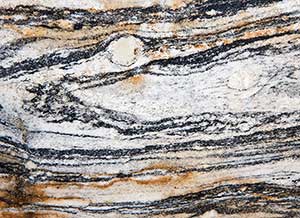
Age of the Earth
So far scientists have not found a way to determine the exact age of the Earth directly from Earth rocks because Earth's oldest rocks have been recycled and destroyed by the process of plate tectonics. If there are any of Earth's primordial rocks left in their original state, they have not yet been found. Nevertheless, scientists have been able to determine the probable age of the Solar System and to calculate an age for the Earth by assuming that the Earth and the rest of the solid bodies in the Solar System formed at the same time and are, therefore, of the same age.
The ages of Earth and Moon rocks and of meteorites are measured by the decay of long-lived radioactive isotopes of elements that occur naturally in rocks and minerals and that decay with half lives of 700 million to more than 100 billion years to stable isotopes of other elements. These dating techniques, which are firmly grounded in physics and are known collectively as radiometric dating, are used to measure the last time that the rock being dated was either melted or disturbed sufficiently to rehomogenize its radioactive elements.
 |
| Acasta Gneiss |
The best age for the Earth (4.54 Ga) is based on old, presumed single-stage leads coupled with the Pb ratios in troilite from iron meteorites, specifically the Canyon Diablo meteorite. In addition, mineral grains (zircon) with U-Pb ages of 4.4 Ga have recently been reported from sedimentary rocks in west-central Australia.
The Moon is a more primitive planet than Earth because it has not been disturbed by plate tectonics; thus, some of its more ancient rocks are more plentiful. Only a small number of rocks were returned to Earth by the six Apollo and three Luna missions. These rocks vary greatly in age, a reflection of their different ages of formation and their subsequent histories. The oldest dated moon rocks, however, have ages between 4.4 and 4.5 billion years and provide a minimum age for the formation of our nearest planetary neighbor.
Thousands of meteorites, which are fragments of asteroids that fall to Earth, have been recovered. These primitive objects provide the best ages for the time of formation of the Solar System. There are more than 70 meteorites, of different types, whose ages have been measured using radiometric dating techniques. The results show that the meteorites, and therefore the Solar System, formed between 4.53 and 4.58 billion years ago. The best age for the Earth comes not from dating individual rocks but by considering the Earth and meteorites as part of the same evolving system in which the isotopic composition of lead, specifically the ratio of lead-207 to lead-206 changes over time owing to the decay of radioactive uranium-235 and uranium-238, respectively. Scientists have used this approach to determine the time required for the isotopes in the Earth's oldest lead ores, of which there are only a few, to evolve from its primordial composition, as measured in uranium-free phases of iron meteorites, to its compositions at the time these lead ores separated from their mantle reservoirs. These calculations result in an age for the Earth and meteorites, and hence the Solar System, of 4.54 billion years with an uncertainty of less than 1 percent. To be precise, this age represents the last time that lead isotopes were homogeneous througout the inner Solar System and the time that lead and uranium was incorporated into the solid bodies of the Solar System.
The age of 4.54 billion years found for the Solar System and Earth is consistent with current calculations of 11 to 13 billion years for the age of the Milky Way Galaxy (based on the stage of evolution of globular cluster stars) and the age of 10 to 15 billion years for the age of the Universe (based on the recession of distant galaxies).